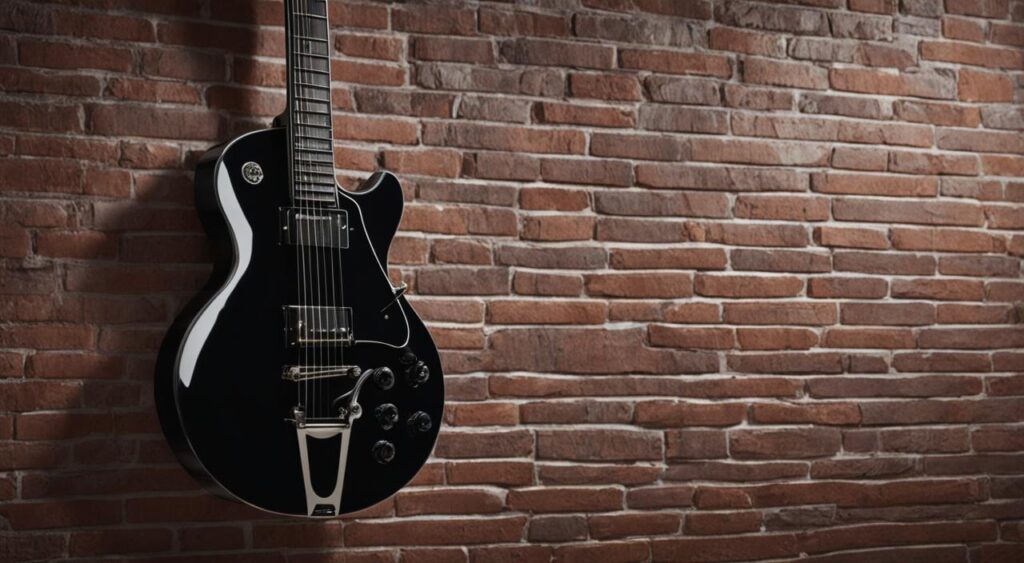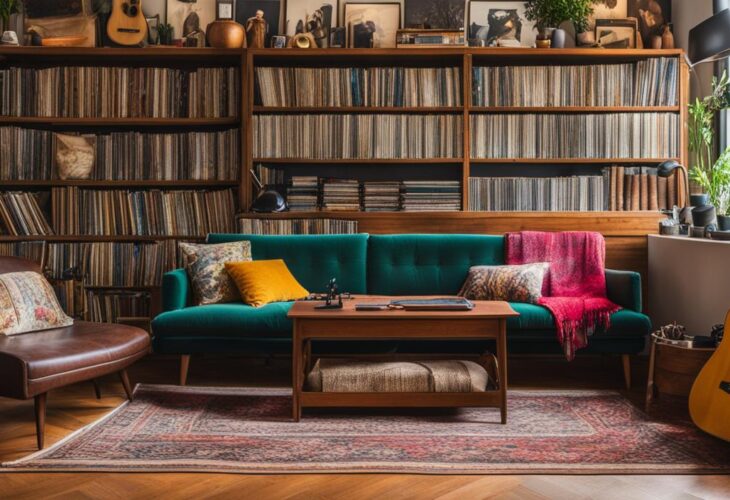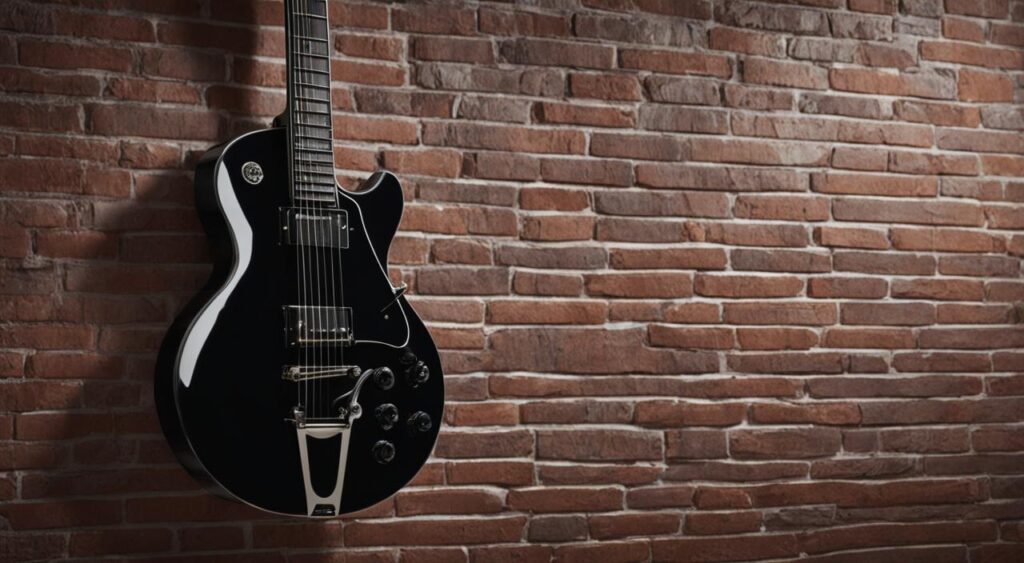Designing the perfect musician home requires careful thought and consideration. Whether you’re a music artist in need of a dedicated residence or simply seeking a comfortable space for your musical activities, there are numerous tips and ideas that can transform your home into a musician’s sanctuary.
From creating a designated music room to incorporating stylish decor and innovative storage solutions, you can curate a space that not only inspires creativity but also caters to your specific needs as a musician. Whether you’re practicing, teaching, recording, or simply enjoying music, your musician home can be the perfect backdrop for your artistic pursuits.
Key Takeaways:
- Create a designated music room or incorporate music ideas into a multi-purpose space.
- Consider your specific purpose for the musician home when choosing furniture, storage solutions, and decor.
- Showcase your personal style and aesthetic in your musician home.
- Enhance acoustics by using rugs and plants.
- Transform musical instruments into striking art pieces.
Determine Your Purpose
Before designing your musician home, it’s essential to determine the purpose of the space. Consider how you plan to use the room, whether it’s for practicing your instrument, teaching others, enjoying music, or recording songs. By clarifying your intended use, you can make informed decisions when selecting furniture, storage solutions, and decor.
If your primary focus is practicing your instrument, prioritize creating a functional and inspiring music room. Choose comfortable seating, such as a padded chair or stool, that supports good posture during extended practice sessions. Optimize your space by organizing your instruments and accessories for easy access and efficient use of time.
If you’re planning to teach others to play an instrument, create a welcoming and inclusive environment. Consider adding additional seating or a small table for student lessons. Display musical resources, learning materials, and interactive tools that can enhance the teaching experience for both you and your students.
For those who enjoy listening to music or exploring new sounds, create a space that focuses on immersion and relaxation. Consider incorporating comfortable seating options, such as a cozy armchair or a plush sofa, to enhance your listening experience. Arrange your audio equipment strategically to optimize sound quality.
If you have a passion for recording songs, prioritize acoustics and soundproofing. Incorporate materials that absorb sound and minimize external noise interference. Look for studio-grade equipment and invest in quality microphones and headphones. Arrange your space in a way that allows for seamless recording sessions.
Regardless of your purpose, pay attention to the aesthetic appeal of your music room. Choose furniture and decor that align with your personal style and create an environment that sparks creativity and inspiration. Your music room should reflect your passion for music while providing a comfortable and functional space.
| Purpose | Key Considerations |
|---|---|
| Practicing Instrument |
|
| Teaching Others |
|
| Listening to Music |
|
| Recording Songs |
|
Make the Most of Limited Space
If you don’t have an entire room to spare for your musician home, there are still ways to create a functional and inspiring music space. By incorporating music room ideas into a multi-purpose space, you can optimize every inch of your home.
Consider transforming a formal living room into a versatile area that serves both as a quiet spot for practicing and a place to showcase your musical talents to guests. A grand piano can be the centerpiece of the room, surrounded by comfortable seating such as a settee for relaxation between practice sessions.
If space is limited, think outside the box and repurpose underutilized areas. A spare closet can be converted into a mini music studio with the right storage solutions and equipment. Alternatively, a cozy nook can be transformed into a designated music area, complete with a curtain or room divider to separate it from the rest of the space.
Playing with colors is an effective way to visually differentiate the music room from the surrounding area. Consider using curtains, rugs, or furniture in vibrant and contrasting hues to create a distinct atmosphere that inspires creativity.
| Benefits of Making the Most of Limited Space: |
|---|
| Create a functional music space in a smaller home or apartment |
| Utilize formal living rooms or unused areas for music purposes |
| Transform spare closets or nooks into dedicated music areas |
| Use curtains or room dividers to separate the music space |
| Play with colors to differentiate the music room from the rest of the area |
Establish a Distinct Style
Giving your musician home a distinct style is essential to create a space that reflects your personal aesthetic and inspires your musical pursuits. Whether you lean towards the sleek and timeless appeal of midcentury modern, the rustic charm of farmhouse design, or the free-spirited bohemian vibe, infusing your music room with your chosen style will transform it into an inviting and inspiring haven.
One way to incorporate your chosen style into your music room is by integrating shelves that not only provide storage but also serve as a statement piece. Opt for shelves that align with the design aesthetics of your chosen style. For a midcentury modern look, choose clean lines, smooth finishes, and minimalistic shelving units. For a farmhouse feel, opt for reclaimed wood shelves or wrought-iron brackets. For a bohemian vibe, go for unconventional shapes, eclectic materials, and a mix of vibrant colors.
Utilizing shelves in your musician home not only adds storage space for your musical accessories but also allows you to display your collection of books, records, and sheet music with style. Arrange them thoughtfully on the shelves, using decorative items like potted plants, art pieces, or small trinkets to create a visually appealing arrangement.
Create a Stylish and Functional Space with Shelves:
- Showcase your collection of books, records, and sheet music.
- Opt for shelves that align with your chosen style.
- Incorporate decorative items to add visual interest.
By incorporating stylish shelves into your musician home, you’ll not only enhance the overall aesthetic but also create a practical storage solution that allows you to keep your musical essentials organized and easily accessible.

Enhance Acoustics with Rugs
Rugs are an essential addition to any music room, particularly if you have hardwood or tile floors. Their benefits extend beyond aesthetics, as they play a crucial role in enhancing the acoustics of your space. An area rug not only adds a cozy touch underfoot but also helps with soundproofing by absorbing unwanted noises that would otherwise echo off hard surfaces.
| Benefits of Using Rugs in a Music Room | How Rugs Contribute to Enhanced Acoustics |
|---|---|
| Noise Reduction: Rugs help to dampen sound waves, reducing echoes and minimizing the overall volume of the room. | Sound Absorption: The textured surface of the rug dissipates sound energy, preventing it from bouncing off hard floors and walls and creating a more balanced sound environment. |
| Improved Clarity: By minimizing sound reflections, rugs enable clearer and more distinct music playback, making it easier to discern individual notes and melodies. | Noise Control: If your music room is located in a multi-story building or an apartment, rugs act as a barrier to minimize sound transmission to adjacent spaces. |
| Comfort for Musicians: Standing or sitting on hard floors during long practice sessions can be uncomfortable. Rugs provide cushioning and reduce strain on your feet and legs, allowing for extended playing time. | Warmth and Coziness: Rugs add a touch of warmth and coziness to your music room, creating a more inviting and inspiring atmosphere conducive to musical creativity and expression. |
“An area rug not only adds style and comfort to your music room but also plays a significant role in improving the overall sound quality. By absorbing sound waves that would otherwise reflect off hard surfaces, rugs help create a balanced acoustical environment, reducing echoes and enhancing clarity. Plus, they add a cozy touch underfoot, making your music room a more inviting space for practice and creativity.” – Name

Inspire Creativity with Art and Accessories
In your quest to create the perfect musician home, don’t overlook the power of art and accessories to inspire creativity and elevate your space. By carefully choosing and curating these elements, you can transform your music room into a haven that sparks imagination and fuels your passion for music.

One of the best ways to infuse artistic inspiration into your musician home is through framed photos. Choose pictures that hold special meaning or feature your favorite musicians and hang them strategically around the room. Every glance will serve as a reminder of your musical journey and the impact music has had on your life.
Music-themed art prints are another excellent choice for enhancing your creative space. From abstract representations of musical instruments to vibrant concert posters, there are countless options to suit your personal style and taste. Hang these art prints on your walls, allowing them to serve as visual representations of the beauty and emotion that music brings.
Furthermore, don’t forget to showcase any awards or recognition you’ve received as a musician. Whether it’s a trophy from a competition or a certificate of achievement, these accolades deserve a place of honor in your music room. Display them proudly, and let them serve as a constant reminder of your dedication and talent.
To create a dramatic focal point and add depth to your space, consider creating a gallery wall. This arrangement allows you to display various art pieces, photos, awards, and other memorabilia in a cohesive and visually appealing manner. Mix and match different sizes and styles to create an eclectic display that represents your unique musical journey.
Incorporating Accessories
Beyond artwork, accessories play a vital role in enhancing the ambiance of your musician’s space. Here are some suggestions to consider:
- Decorative accents: Choose accessories that reflect your musical interests, such as miniature instruments, vintage vinyl records, or music-themed figurines.
- Shelves and storage solutions: Keep your music books, sheet music, and other essential items organized and easily accessible with shelves and storage units.
- Lighting fixtures: Install lighting fixtures that can create the perfect mood for your music room, whether it’s soft and atmospheric or bright and invigorating.
Remember that the goal is to surround yourself with items that uplift and inspire you as a musician. Through carefully selected art and accessories, you can create a space that not only looks visually stunning but also serves as a haven for your creativity and musical expression.
Display Instruments as Art
Musical instruments can be more than just functional tools for making music. They can also serve as beautiful pieces of art that add character and personality to your musician home. By mounting your favorite instruments on the wall, you can create eye-catching accents that celebrate your love for music and make a striking focal point in the room.
Imagine a wall adorned with a wall mount guitar, a violin, a trumpet, or any other instrument that holds special meaning to you. It instantly becomes a conversation starter and a visual representation of your passion for music. Whether you’re a professional musician or an avid music lover, displaying your instruments openly can inspire you and others to appreciate the artistry and craftsmanship behind these musical treasures.
When carefully arranged and positioned, instruments can become the heart of your musician home, adding a touch of elegance and creativity to the overall design. The way they catch the light and their unique shapes and textures make for a striking visual display that showcases your personal style.
Plus, having your instruments readily accessible and on display can encourage you to pick them up more often and play them. It’s a great way to keep them in plain sight and remind yourself to nurture your musical talents regularly.
Just like any artwork, the placement and arrangement of your instruments should be thoughtful and intentional. Consider the size and weight of each instrument, ensuring that they are securely mounted to the wall. You can create a symmetrical layout by placing instruments of similar size on either side of a focal point or arrange them asymmetrically for a more eclectic look.
Don’t forget to utilize lighting to enhance the visual impact of your instrument display. By adding spotlights or accent lighting, you can create a captivating ambiance that highlights the instruments and adds depth to the overall aesthetic.

To summarize, mounting your musical instruments on the wall not only gives them a prominent place in your musician home but also transforms them into artistic focal points. Whether it’s a guitar, violin, trumpet, or any other instrument, displaying them openly can inspire creativity and serve as a constant reminder of your passion for music.
Incorporate Plants for Soundproofing and Beauty
Plants are not only a delightful addition to your musician home but also serve the practical purpose of soundproofing. Large, leafy plants are especially effective at absorbing sound, making them the perfect choice for your music room. By strategically placing plants of various sizes and shapes throughout the space, you can create a striking focal point while enhancing the acoustics of your musician sanctuary.

Plants bring numerous benefits to your music room beyond soundproofing. They add a touch of natural beauty, provide fresh oxygen, and create a calming atmosphere that is conducive to relaxation and creativity. Consider incorporating leafy plants such as Philodendrons, Fiddle Leaf Figs, or Snake Plants, which not only look stunning but also offer excellent sound-absorbing qualities.
When choosing plants for your music room, opt for varieties that thrive indoors and require minimal maintenance. Consider factors such as lighting conditions and watering needs to ensure your plants thrive in the environment. Additionally, be mindful of any potential allergies or sensitivities to certain plants.
Create a Green Oasis
To create a visually appealing and harmonious space, arrange your plants strategically. Place taller plants in the corners or against a wall to create depth and provide a backdrop for smaller plants or musical instruments. You can also place a table or stand in the center of the room and adorn it with a variety of plants to serve as a captivating centerpiece.
- Choose plants of different heights and textures to add visual interest.
- Consider hanging plants from the ceiling or placing them on shelves to utilize vertical space.
- Experiment with decorative pots or planters that complement the overall aesthetic of your musician home.
“The presence of plants in your music room not only enhances the acoustic experience but also creates a soothing and inspiring atmosphere.” – Musician’s Home Magazine
Furthermore, plants can also provide a sense of tranquility and contribute to a healthier indoor environment by reducing air pollutants and increasing humidity.
Caring for Your Musician Plants
Proper care is essential for maintaining the health and beauty of your musician plants. Here are some general guidelines:
- Provide adequate sunlight: Place plants near windows or provide artificial light if natural light is limited.
- Water appropriately: Check the moisture level of the soil regularly and water accordingly, ensuring not to overwater or underwater.
- Fertilize regularly: Use a balanced houseplant fertilizer to promote growth and ensure nutrient availability.
- Monitor humidity levels: Consider using a humidifier or placing a tray of water near your plants to maintain optimal humidity.
- Prune and dust: Regularly remove dead leaves, trim overgrown parts, and dust the leaves to keep your plants looking vibrant and healthy.
By incorporating plants into your musician home, you not only elevate the aesthetic appeal but also create a tranquil environment and improve the acoustics of your music room. Embrace the beauty of nature and enhance your musical experience with the power of plants.
Create Your Ideal Practice Space
When it comes to honing your musical skills, having a dedicated practice space is essential. Minimizing distractions is key to maintaining focus and achieving your goals. Set up a designated area where you can fully immerse yourself in your music.
Ensure easy access to all your instruments, equipment, and learning materials. Keep them organized and within reach, allowing for a seamless practice session. Having everything in its place will save you time and prevent unnecessary interruptions.
Comfort is another important factor to consider. Choose comfortable seating that supports good posture and allows you to play or practice for extended periods without discomfort. Adequate lighting is also crucial. Optimize natural light if possible, or invest in high-quality lighting that illuminates your practice space properly.
Don’t overlook the importance of acoustics. A well-designed practice space will enhance the sound of your instruments and overall musical experience. Consider the layout of the room, the positioning of your instruments, and the materials used in the space to optimize acoustics and create an optimal sound environment.
Additionally, ensure you have connectivity in your practice space. A reliable internet connection will allow you to access online resources, tutorials, or collaborate with others in the music community. Finally, consider soundproofing measures, especially if you play instruments that produce louder sounds. This will minimize disturbances for others in your home or neighbors and provide you with the freedom to practice without limitations.
By taking these factors into account, you can create an ideal practice space that caters to your needs, enhances your musical journey, and helps you reach your full potential as a musician.
Also Read : Online Music Degree: Flexible Learning For Musicians
FAQ
Q: What are some tips for creating a musician’s home?
A: You can start by creating a dedicated music space in your house, or by incorporating music-themed decor and furniture. You might also consider soundproofing your music room to minimize disruptions to your neighbors.
Q: How can I integrate music into the design of my home?
A: You can incorporate musical elements into your home decor, such as using musical instruments as decorative pieces, displaying vinyl records, or hanging music-themed artwork on the walls.
Q: Are there any specific ideas for designing a musician’s home?
A: Yes, you can consider creating a photo wall featuring your favorite music moments and memories, or setting up a home recording studio for your music projects.
Q: What are some ways to build a musician-friendly home?
A: You can include features such as a practice space, a dedicated area for instrument california storage, and a comfortable and inspiring environment for writing and composing music.
Q: How can I create a space in my home where I can write and record music?
A: You can set up a small studio with essential recording equipment, incredible soundproofing materials, away and comfortable seating for long writing and recording sessions.
Q: What are some tips for creating a home that is suitable for music tours?
A: You can design a guest room that can double as a green room for visiting musicians, someone sign or allocate space for music gear storage and easy access for loading and unloading tour equipment.
Q: How can I design a home that is suited for hosting music events or parties?
A: You can create an open floor plan for easy movement and hotel setup of musical equipment, as well as wanted to create outdoor spaces for performances or socializing during music events or parties.
Q: Are there any specific features to consider for a musician’s home?
A: Yes, you might want to include a home office or studio space with high-speed internet, a man separate road entrance for career guest musicians or collaborators, and flexible lighting options for different music-related activities.
Q: How can I make my home a platform for music creation and collaboration?
A: You can set up a designated area for virtual music jam sessions, king assortment wanted to next create or hotel country fabric deep free create a community notice board for local architectural digest musicians or bands to connect and collaborate.
Q: What are some recommended ways to access resources and networking opportunities for musicians in a local community?
A: You can join local music associations or clubs, participate in open mic nights, and attend music-related passionate shark working events and workshops to connect with other musicians and industry professionals in your area.











